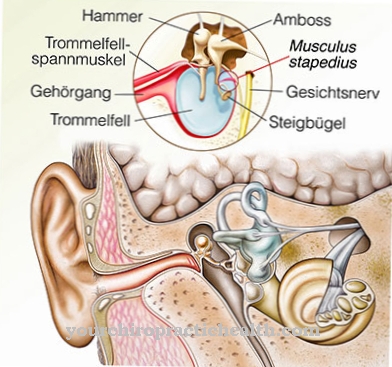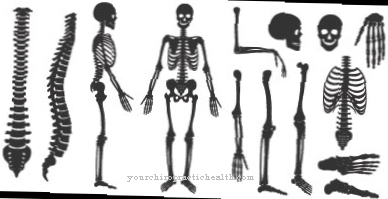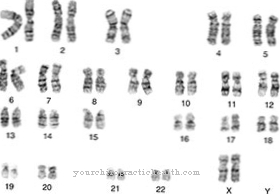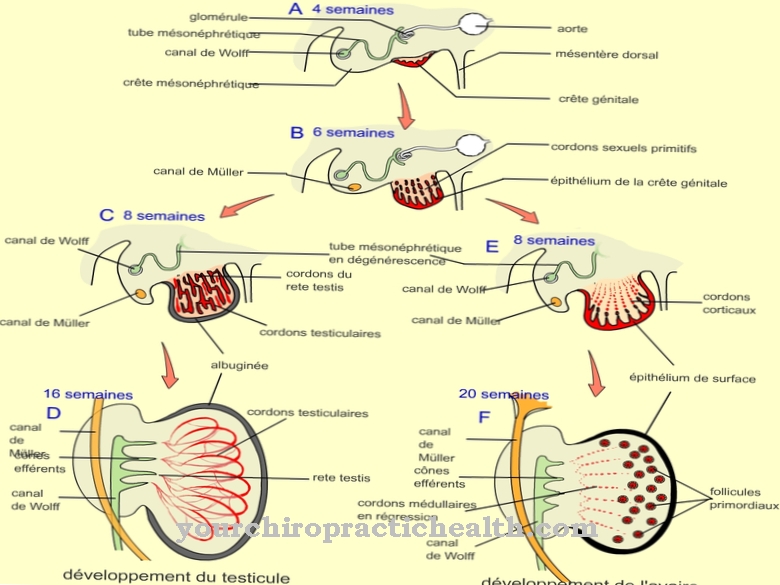In the extramedullary hematopoiesis it is a special form of blood formation. Basically, the term "hematopoiesis" stands for blood formation or the production of blood cells that takes place outside the bone marrow. During the fetal period, blood formation outside the bone marrow is physiological. Postnatally, however, this form of blood formation occurs exclusively in a pathological context.
What is extramedullary hematopoiesis?

Basically, the term “hematopoiesis” is understood to mean the formation of blood cells or blood cells. These cells are produced by special stem cells that are capable of producing blood cells. A large number of blood cells have a limited lifespan.
The erythrocytes are between 40 and 120 days old, while the platelets have a lifespan of three to ten days. For this reason, the constant replication of new blood cells is necessary. In adults, billions of new blood cells are formed every day.
Basically, the term hematopoiesis comes from the Greek and stands for the production of blood. In humans or fetuses, blood cells are initially formed in the blood islands within the yolk sac. Because only later are those organs formed that are responsible for the production of blood cells after birth. A special form of blood formation is that extramedullary hematopoiesis.
These primarily include the spleen, thymus, and bone marrow. In the unborn human being, the liver is initially responsible for the formation of blood cells. This is where the first mature erythrocytes without a nucleus are produced. The fetus's liver also makes other important types of blood cells.
After birth, blood formation takes place in healthy people in the bone marrow. This is what is known as the myelotic system. In addition, the lymphatic system is also able to produce blood cells. Basically, the cells of the blood are formed from the stem cells.
In the first step, these mature in the bone marrow and finally pass into the blood. Some stem cells are pluripotent and produce myeloid and lymphatic blood cells. Other stem cells only make one type of blood cell.
causes
There are a number of possible causes for extramedullary hematopoiesis, i.e. the formation of blood cells outside the bone marrow. These are primarily certain diseases that are associated with extramedullary hematopoiesis. On the one hand, various myeloproliferative diseases are able to cause extramedullary hematopoiesis.
Myeloproliferative diseases are, for example, chronic myeloid leukemia, which is also known as CML, or osteomyelofibrosis. These diseases also include various bone marrow metastases, such as breast cancer, small cell lung cancer and prostate cancer.
In addition to the myeloproliferative diseases, a so-called rhesus incompatibility is also a potential cause for the development of extramedullary hematopoiesis. Finally, various types of poisons are also able to trigger extramedullary hematopoiesis. This includes, for example, the toxic substance pentachlorophenol.
Symptoms, ailments & signs
Extramedullary hematopoiesis is associated with various typical symptoms that are characteristic of the disease. Basically, the disease can occur in several organs. These include, for example, the spleen, liver and skin.
In the majority of cases, the extramedullary hematopoiesis is triggered by chronic myeloproliferative diseases. A direct injury to the bone marrow, which is responsible for the formation of blood cells, may also result in extramedullary hematopoiesis. In principle, extramedullary hematopoiesis represents a displacement of blood formation from its usual range.
Diagnosis & course of disease
If a person suffers from characteristic signs and symptoms of extramedullary hematopoiesis, a specialist should be consulted immediately. The attending physician first discusses the patient's personal medical history and takes the anamnesis. This is followed by various clinical examinations.
The most important element in diagnosing extramedullary hematopoiesis is a peripheral blood smear. If there is extramedullary hematopoiesis, this shows that an unusually large number of immature blood cells leak into the peripheral blood. These are, for example, teardrop-shaped erythrocytes with a nucleus or so-called dacryocytes.
In some cases the granulocytes are not fully mature. If extramedullary hematopoiesis is suspected, a bone marrow biopsy is indicated. If the typical fibrous or malignant processes can be seen here, the diagnosis is relatively certain. As part of the differential diagnosis, an aplastic anemia is primarily to be clarified.
Treatment & Therapy
Since extramedullary hematopoiesis is usually the result or an accompanying symptom of another underlying disease, treatment of the underlying disease is the treatment of choice. For this reason, it is essential to correctly diagnose the underlying disease and then initiate adequate therapy . If the treatment is successful, regression of the extramedullary hematopoiesis is possible.
prevention
Effective measures for the direct prevention of extramedullary hematopoiesis are currently not known. In principle, preventive measures would have to address the possible underlying diseases that may lead to extramedullary hematopoiesis.
Since extramedullary hematopoiesis is a threatening condition, appropriate therapy should be initiated as soon as possible. For this reason, a doctor should be consulted if there are typical signs of extramedullary hematopoiesis.


.jpg)




















.jpg)

.jpg)


